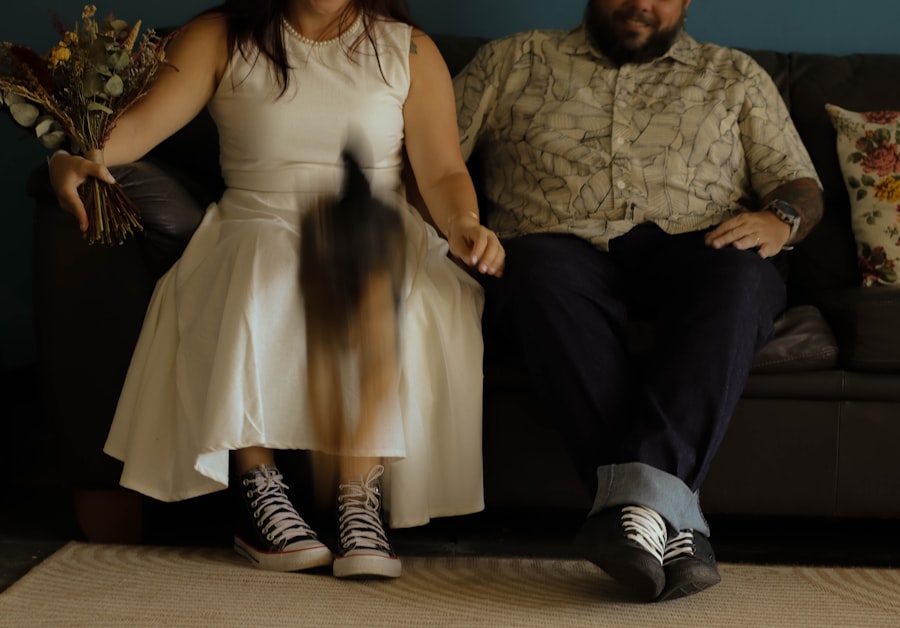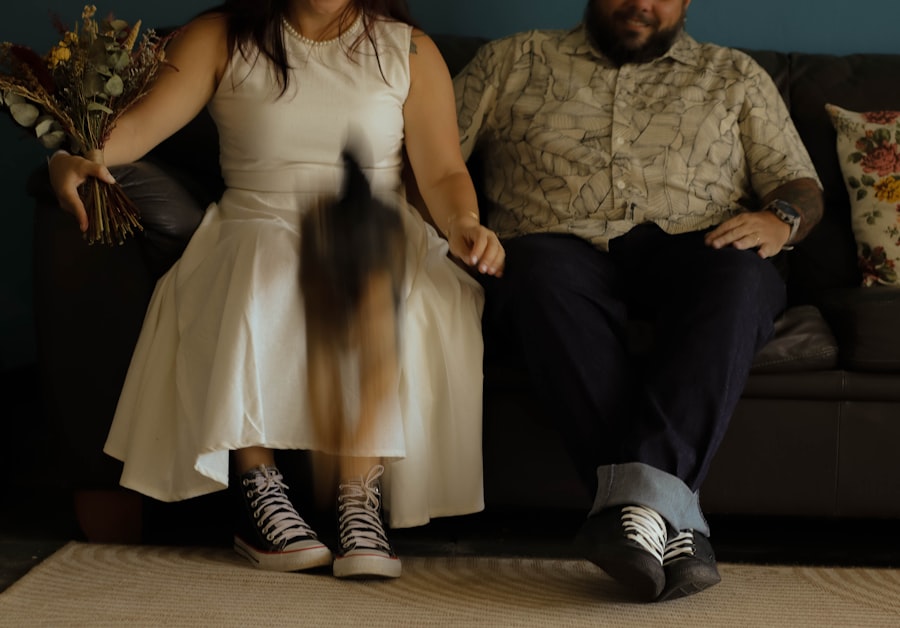Every story has a beginning, and mine was no different. I remember the day I realized that my marriage was heading toward its inevitable conclusion. It wasn’t a single moment but rather a series of small, seemingly insignificant events that piled up like snowflakes until they became an avalanche.
I had always believed that love could conquer all, but as the years went by, I found myself questioning that notion. The laughter that once filled our home was replaced by silence, and the warmth of companionship turned into a cold distance. I often replayed the moments in my mind, searching for the exact point where things began to unravel.
Was it the late nights at work? The missed anniversaries? Or perhaps it was the growing resentment that festered beneath the surface?
As I navigated through this emotional labyrinth, I began to see the cracks in our relationship more clearly. Conversations that once flowed effortlessly became stilted and awkward. I found myself longing for the connection we once shared, but it felt like trying to grasp smoke with my bare hands.
The realization hit me hard: we were no longer partners but rather two individuals cohabiting in a space that had lost its meaning. I often wondered if we had simply grown apart or if we had been living in denial, clinging to the remnants of what once was. The beginning of the end was not marked by a dramatic confrontation but rather a quiet acceptance that our love story was reaching its final chapter.
Key Takeaways
- The beginning of the end: Understanding how the relationship started to unravel
- The “honeymoon phase” and other lies: Recognizing the false expectations of a perfect relationship
- The art of passive-aggressive communication: Navigating the toxic dynamics of unhealthy communication
- The joy of compromise (not really): Understanding the sacrifices and resentment that come with compromise
- When “till death do us part” becomes “till I can’t take it anymore”: Recognizing the breaking point in a marriage
The “Honeymoon Phase” and Other Lies
Ah, the honeymoon phase—those blissful months (or years) when everything feels perfect, and love is intoxicating. I remember how everything seemed magical during that time.
But as I look back now, I realize that this phase was more of a mirage than a solid foundation. It was as if we were living in a bubble, one that eventually burst to reveal the reality beneath. The truth is, the honeymoon phase is often built on illusions and unspoken expectations.
We were so caught up in our idealized versions of each other that we failed to see the flaws lurking just beneath the surface. As time went on, those initial sparks of passion faded, and the mundane realities of life crept in. The little quirks that once seemed endearing began to grate on my nerves.
I found myself questioning whether we had ever truly known each other or if we had merely fallen in love with an idea. The lies we told ourselves during that honeymoon phase became painfully evident as we faced the challenges of everyday life. It was a harsh awakening, one that left me feeling disillusioned and yearning for something more substantial than fleeting moments of joy.
The Art of Passive-Aggressive Communication

Communication is often touted as the cornerstone of any successful relationship, yet I found myself trapped in a web of passive-aggressive exchanges. Instead of addressing our issues head-on, we resorted to veiled comments and sarcastic remarks that only deepened the divide between us. It was as if we had both agreed to dance around our problems rather than confront them directly.
I would drop hints about my frustrations, hoping he would pick up on them without me having to spell it out. But instead of fostering understanding, this approach only led to more misunderstandings and resentment. I became an expert at reading between the lines, deciphering his cryptic messages while simultaneously sending my own mixed signals.
It was exhausting and frustrating, leaving me feeling unheard and unappreciated. I often wondered if this was how relationships were meant to function or if we had simply fallen into a toxic pattern that neither of us knew how to break. The art of passive-aggressive communication became our default mode, and as much as I tried to change it, I felt powerless against the tide of unspoken grievances that threatened to drown us both.
The Joy of Compromise (Not Really)
| Metrics | Data |
|---|---|
| Number of Compromises | 10 |
| Level of Satisfaction | Low |
| Time Spent on Negotiation | 5 hours |
| Number of Parties Involved | 3 |
Compromise is often heralded as a vital skill in any relationship, but in my experience, it felt more like a game of tug-of-war than a harmonious agreement. I would bend over backward to accommodate his needs while my own desires were pushed aside like an afterthought. It was as if compromise had become synonymous with sacrifice, and I found myself resenting the very act that was supposed to bring us closer together.
Each time I conceded to his wishes, I felt a piece of myself slip away, leaving me feeling hollow and unfulfilled. The irony is that compromise should ideally foster mutual respect and understanding, yet it often felt like a one-sided affair. I would agree to things I didn’t truly want just to keep the peace, but deep down, I knew this wasn’t sustainable.
The joy of compromise quickly turned into a bitter pill to swallow as I realized that my own happiness was being sacrificed on the altar of marital harmony. It became clear that true compromise requires both parties to be willing to give and take equally—a lesson I learned too late.
When “Till Death Do Us Part” Becomes “Till I Can’t Take It Anymore”
The vows we exchanged on our wedding day echoed in my mind long after they lost their meaning. “Till death do us part” felt like a promise etched in stone, yet as time passed, it morphed into a haunting reminder of what once was. There came a point when I realized that love alone wasn’t enough to sustain our marriage; it required effort, understanding, and a willingness to grow together.
Unfortunately, those elements were sorely lacking in our relationship. As much as I wanted to honor those vows, I also recognized that there comes a time when self-preservation must take precedence over blind loyalty. I reached a breaking point where staying in the marriage felt more like a prison sentence than a commitment.
The weight of unaddressed issues became unbearable, and I found myself questioning whether enduring this pain was worth it anymore. “Till I can’t take it anymore” became my new mantra—a stark contrast to the romantic ideals I once held dear. It was a painful realization that sometimes love isn’t enough; sometimes, walking away is the bravest choice one can make.
The Delight of Divorce Lawyers and Paperwork

Once the decision was made, I found myself thrust into a world filled with divorce lawyers and mountains of paperwork—an experience I never anticipated would be so overwhelming. The legal jargon felt foreign and intimidating as I navigated through forms and documents that seemed designed to confuse rather than clarify. Each meeting with my lawyer felt like an exercise in frustration as we dissected every aspect of our lives together—assets, debts, custody arrangements—everything laid bare for scrutiny.
I quickly learned that divorce is not just an emotional process; it’s also a logistical nightmare. The sheer volume of paperwork required made me feel like I was drowning in bureaucracy. It was disheartening to see our once-shared dreams reduced to legal terms and financial negotiations.
As much as I wanted to focus on healing and moving forward, the reality of divorce demanded my attention in ways I hadn’t anticipated.
Splitting Assets: A Fun Game of Who Gets What
The process of dividing assets felt like playing an elaborate game where neither player truly wins. What once symbolized our shared life together now became points of contention—who gets the house? What about the car? And let’s not forget about those sentimental items that held memories but now felt like burdens weighing me down. Each negotiation felt like peeling back layers of our relationship, revealing not just material possessions but also emotional attachments tied to those items. I found myself grappling with feelings of anger and sadness as we navigated this minefield together. It was surreal to think that these objects could hold so much power over our lives post-divorce. In many ways, splitting assets became a reflection of our relationship itself—filled with disagreements and unresolved feelings that lingered long after the ink dried on the papers.
The Awkwardness of Telling Friends and Family
Once the decision was made public, I braced myself for the inevitable conversations with friends and family—those awkward exchanges filled with pitying glances and well-meaning advice. Telling loved ones about my divorce felt like admitting defeat; it was as if I were confessing to some grand failure rather than sharing a significant life change. Their reactions varied from shock to sympathy, each response adding another layer of complexity to an already challenging situation.
I often found myself rehearsing what to say before each conversation, trying to strike a balance between honesty and self-preservation. Some friends offered support while others seemed unsure how to navigate this new reality with me. It was during these moments that I realized how isolating divorce can be; even surrounded by people who care about me, there were times when I felt utterly alone in my experience.
The Liberation of Living Alone (Finally!)
As daunting as it seemed at first, living alone turned out to be one of the most liberating experiences of my life. No longer did I have to navigate someone else’s preferences or compromise on my own desires; instead, I could create an environment that truly reflected who I am. The silence in my home initially felt strange after years of shared living but soon transformed into a comforting presence—a space where I could finally breathe without judgment or expectation.
I reveled in the freedom to decorate my space however I pleased, indulge in late-night snacks without sharing, and enjoy solitary moments without feeling guilty about neglecting someone else’s needs. Living alone allowed me to rediscover myself outside the confines of marriage—a journey filled with self-reflection and personal growth that had been stifled for far too long.
The Hilarious World of Online Dating After Divorce
Once I felt ready to dip my toes back into the dating pool, online dating became my new adventure—a hilarious rollercoaster ride filled with unexpected twists and turns. Crafting my profile felt like writing an autobiography condensed into a few witty sentences while trying not to sound desperate or jaded from my previous experience. Swiping left and right quickly became second nature as I navigated through profiles filled with everything from charming bios to cringe-worthy photos.
The dates themselves were often comical disasters—awkward silences punctuated by forced laughter or mismatched expectations leading to uncomfortable conversations about ex-spouses and future aspirations. Yet amidst the chaos, there were moments of genuine connection that reminded me why dating can be exciting despite its challenges. Each encounter brought me closer to understanding what I truly wanted in a partner while also providing ample material for future stories.
Finding Peace and Happiness in the Chaos of Divorce
Amidst all the turmoil and uncertainty surrounding divorce, there emerged glimmers of hope—moments where peace began to seep into my life once more. It took time and effort, but gradually, I learned how to embrace this new chapter with open arms rather than resist it out of fear or regret. Finding happiness amidst chaos became my mantra; instead of dwelling on what was lost, I focused on what lay ahead.
I discovered new hobbies, reconnected with old friends, and even took time for self-care practices that nourished my soul—activities that had long been neglected during my marriage. Through this journey toward healing, I realized that happiness isn’t solely dependent on external circumstances; it’s also about cultivating an inner sense of peace regardless of what life throws my way. In conclusion, divorce may have marked the end of one chapter in my life, but it also opened doors to new beginnings filled with possibilities waiting to be explored.
While there were challenges along the way—from navigating legalities to facing emotional upheaval—I emerged stronger than ever before armed with lessons learned from both love and loss alike.
In a world where love stories often end with “happily ever after,” it’s refreshing to find tales that embrace the chaos and humor of real-life relationships. Take, for instance, the sarcastic divorce story that has everyone chuckling and nodding in agreement. If you enjoyed that, you’ll likely appreciate another gem that delves into the quirks of modern relationships. Check out this related article on Ami Wrong Here, where the complexities of love and separation are explored with a delightful twist of irony and wit. It’s a reminder that sometimes, the best way to cope with life’s unexpected turns is through a good laugh.
WATCH THIS! 💔 She Funded Her Affair With My Bank Account (Am I Wrong Here?)
FAQs
What is a sarcastic divorce story?
A sarcastic divorce story is a humorous and satirical retelling of a divorce experience, often using irony, sarcasm, and wit to convey the emotions and events involved in the process.
What are some common themes in sarcastic divorce stories?
Common themes in sarcastic divorce stories include the absurdity of the legal system, the complexities of relationships, the emotional rollercoaster of divorce, and the often comical aspects of navigating the process.
Are sarcastic divorce stories meant to be taken seriously?
Sarcastic divorce stories are not meant to be taken literally or as a reflection of real-life experiences. They are a form of creative expression and humor, often used to provide a lighthearted take on a serious and challenging life event.
What is the purpose of a sarcastic divorce story?
The purpose of a sarcastic divorce story is to provide a humorous and relatable perspective on the experience of divorce. It can serve as a form of catharsis for those going through a divorce, as well as a way to entertain and connect with others who have experienced similar situations.
Are sarcastic divorce stories appropriate for all audiences?
Sarcastic divorce stories may contain mature themes and language, so they may not be suitable for all audiences. It’s important to consider the intended audience and the context in which the story is being shared.




